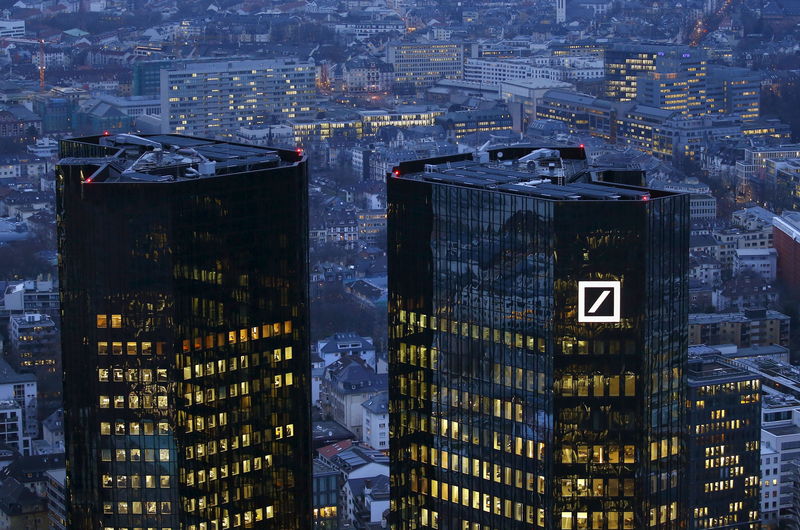By Danilo Masoni
MILAN (Reuters) - Uncertainty about the timing and scope of regulatory efforts to strengthen Europe's financial system is adding to investor caution about increasing exposure to European over U.S. banks, even as the economy and earnings improve.
European bank stocks, overshadowed by some 800 billion euros of soured loans from the financial crisis, rallied in the first half of the year after the election of French President Emmanuel Macron removed an element of political risk and data showed the region's economy recovering at a stronger-than-expected pace.
But the rally has faltered, partly over concerns that new rules being drawn up separately in Frankfurt and Basel could spark a fresh wave of cash calls and jeopardize dividends.
"Regulation is the true obstacle. If it were about the economy, investors would be buying banks," said Andrea Filtri, London-based banking analyst at Italy's Mediobanca Securities.
Top of mind for many investors is the work of the European Central Bank, which proposed in October that banks set aside more cash to cover bad loans, a measure that would force weak lenders to ask shareholders to provide the cash to plug losses.
Lawmakers in Italy said the rules would thwart lending to small and medium-sized firms and might even choke out growth. Following Italy's lead, some European lawmakers also said the central bank was reaching beyond its mandate.
The new rules were due to kick in on Jan. 1, 2018, but top ECB supervisor Daniele Nouy said last week a few more months were needed because of the intense pushback. Sources have told Reuters the delay could last as long as a year.
Adding to the uncertainty is what will emerge from the Basel Committee of global regulators working to complete post-financial crisis capital requirements.
Citi Research analysts estimated in a report that in a worst case scenario, the "Basel IV" rules could turn a capital surplus of 64 billion euros ($76 billion) at European banks into a 162 billion-euro deficit.
Basel IV was supposed to have been agreed by the end of last year but a row between France and the United States over how high to set the capital demands has dragged out the process. France's central bank governor said a deal may be reached as soon as this Thursday.
"We are in the middle of a war and when overseas investors see a conflict they just prefer to stay out of it," said Filtri.
Portfolio managers like Luiz Sauerbronn at Brandes Investment Partners are confining their European banking holdings to well-capitalized companies until the picture clears.
"It's very uncertain: we don't know what regulators are thinking and if they're making a decision yet," said Sauerbronn, who helps manage $30 billion at the San Diego, Calif.-based investment advisory firm.
U.S. SKIES ARE CLEAR
While European lenders brace for tougher regulatory requirements, the Federal Reserve is signaling lighter rules and has given U.S. banks approval to use extra capital to reward shareholders.
The ECB has also signaled it will wait far longer than the Fed to raise interest rates, depriving European banks of potential earnings on loans.
Those factors have contributed to a surge of net cumulative flows into U.S. financial funds this year to a high of more than $12 billion in November, according to Boston-based fund tracker EPFR Global. While flows into Europe have also risen in 2017, they plateaued before reaching $4 billion in November, it said.
European bank stocks (SX7P), which like other cyclical sectors are sensitive to the economy, are down 5 percent from their May peak, twice as much the broader market's decline (STOXX). U.S. banks have gained 17 percent over the same period.
European banks remain thinly capitalized compared with their U.S. brethren because regulatory scrutiny in the United States has historically been more stringent than in Europe, leading investors like Sauerbronn to see U.S. banks as safer.
The ECB's latest efforts are centered on Italian banks which hold nearly a third of the euro zone's non-performing loans.
NPLs at Italian banks are worth 12 percent of their assets, data from the European Banking Authority shows, against a European Union average of 4.5 percent.
"The direction of travel is clear: the ECB is very focused on getting banks to have a non-performing loans exposure of single-digit percentages within a reasonable time frame," said Matthew Williams, analyst for global financials at Carmignac, which manages 60 billion euros.
An extra 20-25 billion euros of capital would be needed to bring Italy's soured debt exposure to within the ECB's aim, he said. "That affects how we think of investment opportunities: we're not convinced that it's the right time to be involved in smaller Italian banks."
Basel IV will govern how banks internally calculate risk, which determines how much cash they set aside, and aim to bring European banks up to U.S. standards.
The Basel IV announcement is unlikely to result in any bank having to tap investors for cash because implementation is expected to be very gradual, however.
Williams at Carmignac reckons the immediate market reaction could be negative, as it was unlikely that many banks would be able to pay special dividends once Basel IV is agreed.
But the decision itself could trigger relief, analysts say.
"Putting a line under the Basel IV uncertainty would be a positive for the sector which is plagued by continued regulatory uncertainty to this day," Filtri wrote in a note for clients.
